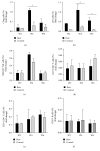The Repeated Administration of Resveratrol Has Measurable Effects on Circulating T-Cell Subsets in Humans
- PMID: 28546852
- PMCID: PMC5435979
- DOI: 10.1155/2017/6781872
The Repeated Administration of Resveratrol Has Measurable Effects on Circulating T-Cell Subsets in Humans
Abstract
Preclinical studies have shown that resveratrol exerts immunomodulatory effects with potential clinical value in the amelioration of autoimmune disorders and cancer prevention; however, little is known about the in vivo effects of this naturally occurring polyphenol on human immune cells. We assessed the effects of repeated doses of resveratrol (1000 mg/day for 28 days) on circulating immune cells in healthy Japanese individuals. Resveratrol was safe and well tolerated and was associated with significant increases in the numbers of circulating γδ T cells and regulatory T cells and resulted in small, yet significant, decreases in the plasma levels of the proinflammatory cytokines TNF-α and MCP-1 and a significant increase in the plasma antioxidant activity compared with the corresponding antioxidant baseline activity and with that in four control individuals. In in vitro studies, resveratrol significantly improved the growth of γδ T cells and regulatory T cells. These findings demonstrate that resveratrol has some clear biological effects on human circulating immune cells. Further studies are necessary to interpret the long-term immunological changes associated with resveratrol treatment.
Figures





Similar articles
-
Resveratrol induces the suppression of tumor-derived CD4+CD25+ regulatory T cells.Int Immunopharmacol. 2008 Apr;8(4):542-7. doi: 10.1016/j.intimp.2007.12.006. Epub 2008 Jan 16. Int Immunopharmacol. 2008. PMID: 18328445
-
Resveratrol prevents suppression of regulatory T-cell production, oxidative stress, and inflammation of mice prone or resistant to high-fat diet-induced obesity.Nutr Res. 2013 Nov;33(11):971-81. doi: 10.1016/j.nutres.2013.07.016. Epub 2013 Aug 27. Nutr Res. 2013. PMID: 24176237
-
The phytogestrogenic stilbenes, arachidin-1 and resveratrol, modulate regulatory T cell functions responsible for successful aging in aged ICR mice.Int J Mol Med. 2016 Dec;38(6):1895-1904. doi: 10.3892/ijmm.2016.2792. Epub 2016 Oct 27. Int J Mol Med. 2016. PMID: 27840891
-
Regulatory effects of resveratrol on glucose metabolism and T-lymphocyte subsets in the development of high-fat diet-induced obesity in C57BL/6 mice.Food Funct. 2014 Jul 25;5(7):1452-63. doi: 10.1039/c3fo60714c. Food Funct. 2014. PMID: 24812660
-
Resveratrol enhances TNF-α production in human monocytes upon bacterial stimulation.Biochim Biophys Acta. 2014 Jan;1840(1):95-105. doi: 10.1016/j.bbagen.2013.09.009. Epub 2013 Sep 12. Biochim Biophys Acta. 2014. PMID: 24035785 Clinical Trial.
Cited by
-
New insights into immunomodulation via overexpressing lipoic acid synthase as a therapeutic potential to reduce atherosclerosis.Vascul Pharmacol. 2020 Oct-Nov;133-134:106777. doi: 10.1016/j.vph.2020.106777. Epub 2020 Aug 1. Vascul Pharmacol. 2020. PMID: 32750408 Free PMC article.
-
Effects of Natural Polyphenols on Oxidative Stress-Mediated Blood-Brain Barrier Dysfunction.Antioxidants (Basel). 2022 Jan 20;11(2):197. doi: 10.3390/antiox11020197. Antioxidants (Basel). 2022. PMID: 35204080 Free PMC article. Review.
-
Protective Effects of Dietary Resveratrol against Chronic Low-Grade Inflammation Mediated through the Gut Microbiota in High-Fat Diet Mice.Nutrients. 2022 May 10;14(10):1994. doi: 10.3390/nu14101994. Nutrients. 2022. PMID: 35631150 Free PMC article.
-
Licochalcone A improves the cognitive ability of mice by regulating T- and B-cell proliferation.Aging (Albany NY). 2021 Mar 10;13(6):8895-8915. doi: 10.18632/aging.202704. Epub 2021 Mar 10. Aging (Albany NY). 2021. PMID: 33714945 Free PMC article.
-
Targeting Glucose Metabolism to Enhance Immunotherapy: Emerging Evidence on Intermittent Fasting and Calorie Restriction Mimetics.Front Immunol. 2019 Jun 25;10:1402. doi: 10.3389/fimmu.2019.01402. eCollection 2019. Front Immunol. 2019. PMID: 31293576 Free PMC article. Review.
References
-
- Patel K. R., Scott E., Brown V. A., Gescher A. J., Steward W. P., Brown K. Clinical trials of resveratrol. Annals of the New York Academy of Sciences. 2011;1215(1):161–169. - PubMed
Publication types
MeSH terms
Substances
LinkOut - more resources
Full Text Sources
Other Literature Sources
Miscellaneous

